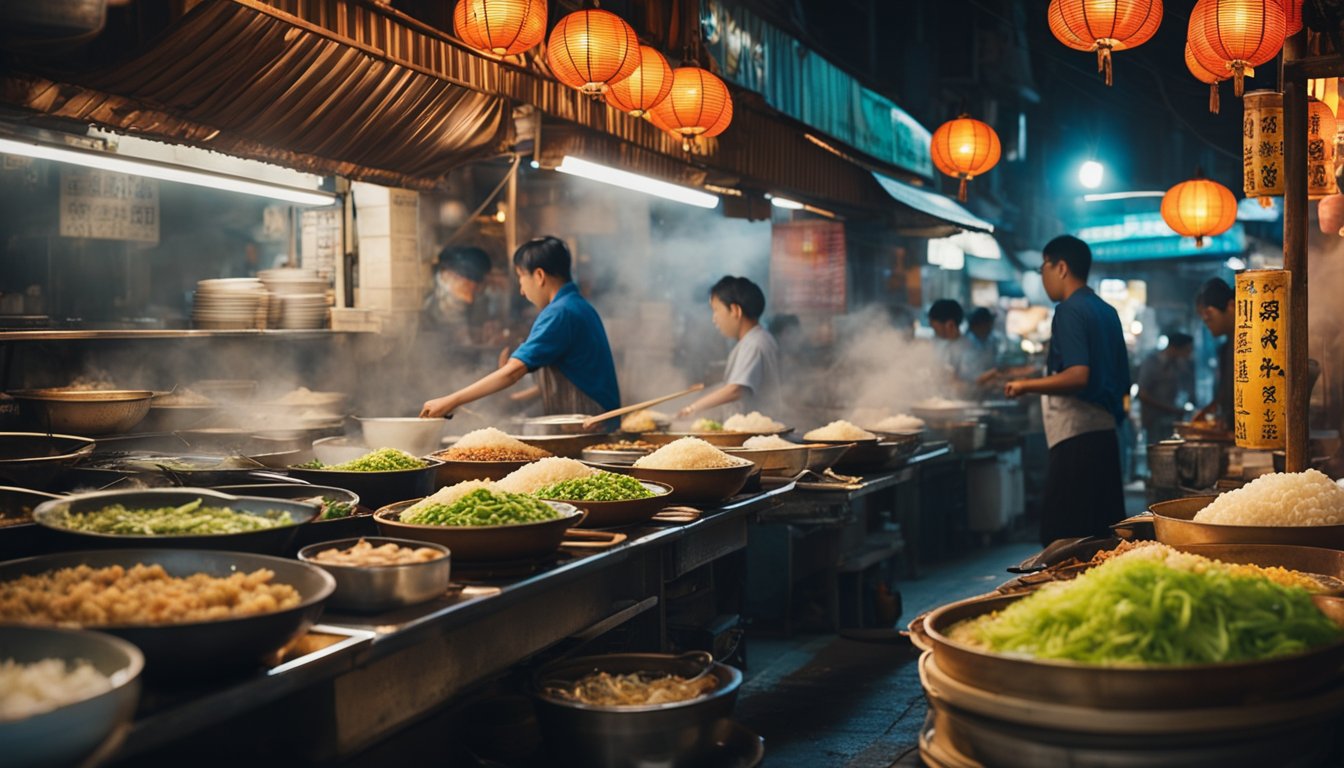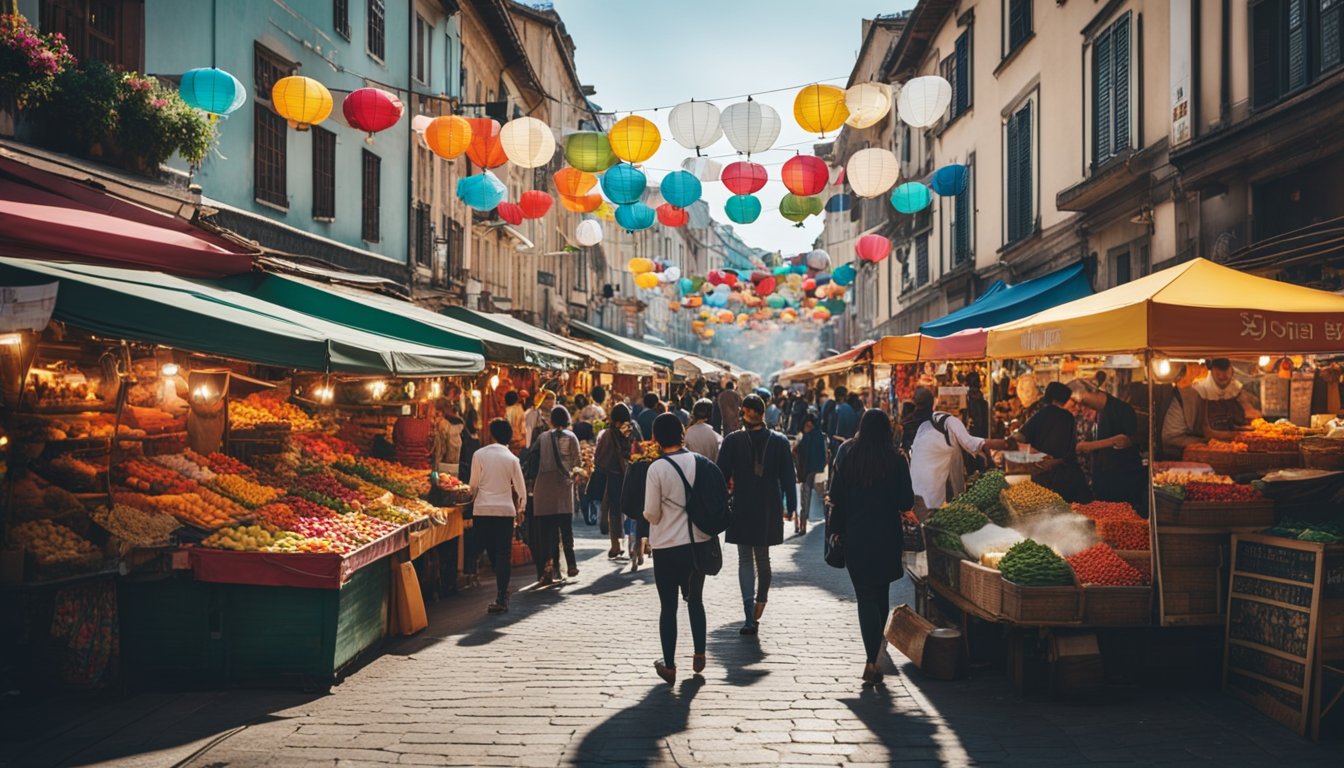Vientiane, the bustling capital of Laos, presents a vibrant tapestry of culinary delights, prominently featuring an array of street food that appeals to tourists and locals alike. The streets of Vientiane are lined with vendors and stalls, each offering a taste of the country’s rich flavors and traditions. These range from savory barbecued meats to sweet, sticky rice desserts, reflecting the diverse influences that have shaped Lao cuisine over the centuries.

One cannot visit the city without indulging in the popular street food staple, Khao Jee, a Lao-style baguette filled with pork, pate, and a generous helping of fresh and pickled vegetables. For those with more adventurous palates, Vientiane’s street food scene provides ample opportunity to sample dishes like Larb, a spicy meat salad that is considered the national dish of Laos, often served with sticky rice.
Finding these delicious eats is easy; they are ubiquitous throughout the city, from the morning markets to the night stalls along the Mekong River. The atmosphere surrounding the street food experience in Vientiane is as much a part of the adventure as the food itself. Eating becomes an interactive journey through the city’s culinary soul, full of unusual flavors and authentic Lao culture.
The Heart of Vientiane’s Cuisine

Vientiane’s street food is a vibrant tapestry woven from the local ingredients and traditional recipes that have been passed down through generations.
Signature Street Food Dishes
Larb, often considered the national dish of Laos, is a meat salad that can be made with chicken, beef, pork, or duck. These meats are finely chopped, seasoned with lime juice, garlic, and fish sauce, and often mixed with roasted rice powder, adding a unique texture.
Another staple is Lao sausage, a flavorful blend of pork laced with lemongrass, garlic, and sometimes chilies, encapsulating the robust flavors of the region. Served with sticky rice, the ubiquitous accompaniment, it’s a combination that typifies Lao street food.
Ingredient Spotlight: Local Flavors
Sticky rice is at the core of every meal and is customarily enjoyed with the hands. It’s a glutinous rice that manages to be the perfect vehicle for soaking up the rich flavors of Lao cuisine.
Padaek, a traditional Lao condiment made from fermented fish, brings a pungent depth to dishes like laap (or laab). Fish sauce, lime juice, and roasted rice powder combine to balance sour, salty, and nutty notes.
Garlic and peanuts appear frequently, offering respectively a sharp aromatic kick and a crunchy contrast. Dishes are often finished with a spoonful of coconut cream, adding a subtle sweetness that rounds off the robust flavors. Fresh produce and herbs are sourced directly from the local markets, ensuring each dish bursts with the area’s authentic tastes.
Vegetarian and Special Dietary Options

In Vientiane, vegetarian street food is plentiful and varied, offering flavorsome options for those with special dietary preferences. Hearty ingredients like tofu and mushrooms feature prominently, along with fresh salads such as the green papaya salad.
Vegetarian Street Food Varieties
Tofu Dishes:
Visitors will find tofu in many forms on the streets of Vientiane. From fried tofu to tofu skewers, it is often seasoned with local herbs and spices to enhance its flavor.
- Tam Mak Hoong (Green Papaya Salad):
This is a staple in Laotian cuisine and can be made vegetarian-friendly. The salad consists of shredded green papaya, carrots, tomatoes, Thai chilies, and is typically seasoned with lime juice, tamarind juice, fish sauce (which can be omitted for a strict vegetarian version), palm sugar, and garlic.
Mushroom Specialties:
Several street vendors specialize in mushroom-based dishes. These can range from grilled mushrooms on skewers to mushrooms stir-fried with vegetables. Mushrooms provide a meaty texture that is satisfying for vegetarians seeking a filling meal.
- Vegetable Stir Fries:
Streets are lined with vendors offering stir-fried vegetables. These may include a mix of local greens, bean sprouts, and other seasonal veggies. Typically, these can be ordered with or without tofu, making them a flexible option for various dietary requirements.
By incorporating ingredients like tofu and mushrooms, Vientiane’s street food scene ensures that vegetarian offerings are not only abundant but also rich in nutrients and local flavors.
Drinks and Refreshments

Vientiane’s vibrant street food scene is complemented by a variety of drinks and refreshments that are as much a part of the culinary experience as the food itself.
Local Beverages and Coffee Culture
Vientiane boasts an array of traditional beverages, often infused with flavors like lemongrass and mint. Street vendors and local cafes provide an authentic taste of Lao’s drink specialties. Among these, iced mint refreshments are particularly popular, offering a cool respite from the city’s tropical heat.
| Ingredient | Drink | Description |
|---|---|---|
| Coffee | Lao Coffee | A potent brew often sweetened with condensed milk |
| Lemongrass | Lemongrass Juice | A fragrant, refreshing drink with a citrusy flavor |
| Mint | Mint Cooler | A minty concoction that is both refreshing and aromatic |
Lao coffee culture is an experience in itself, with the rich, strong coffee often served over ice with a layer of sweetened condensed milk. Small, local coffee stalls can be found on many street corners, each with their own unique twist on the country’s renowned coffee, which is gaining popularity for its robust flavor and is commonly grown in the Bolaven Plateau.
Many drinks are served cold with crushed ice, making them a delightful treat amidst the heat and bustle of Vientiane’s streets. Visitors should not miss the chance to enjoy these refreshing drinks as they explore the varied tastes the city has to offer.
Food Markets and Dining Spots

Vientiane boasts a vibrant street food scene, epitomized by its bustling night markets and quaint morning stalls. Visitors seeking an authentic taste of the city flock to these spots for a culinary adventure.
Ban Anou Night Market
The Ban Anou Night Market, situated near the lively Chao Anou Road, comes alive as dusk settles over Vientiane. Stalls teem with locals and tourists alike, offering an array of Lao delicacies. Here, one can experience grilled meats and sticky rice, savored by the nearby Mekong River for an idyllic dining backdrop. The market’s intimate connection with local culture makes it a must-visit destination for those wanting to immerse themselves in the city’s food scene.
Morning Market
With the break of dawn, Vientiane’s Morning Market (also known as Talat Sao) becomes a hub of activity. It provides a glimpse into the everyday lives of the locals who frequent the market for fresh produce and breakfast offerings. The labyrinth of stalls within the Morning Market allows adventurers to explore the variety of foods available, from traditional soups to sweet snacks. Not only is it a place for food, but Lane Xang Avenue’s proximity also offers convenience for those looking to combine their culinary discovery with some shopping.
Notable Street Food Restaurants
Aside from markets, Vientiane boasts a selection of notable restaurants that elevate the street food dining experience. These establishments bring the essence of Vientiane’s street food into a sit-down setting. For example:
- Restaurant A: Known for superb Laap (minced meat salad), located near the Morning Market.
- Restaurant B: Offers an impressive view of the Mekong River alongside a menu of grilled fish dishes.
- Restaurant C: A favored spot along Lane Xang Avenue, praised for its Pho variations that tantalize the palate.
For those preferring a more structured dining experience, these restaurants provide a different yet equally enriching taste of Vientiane’s food culture.
Culinary Adventures in Vientiane

Vientiane offers a gastronomic journey that tantalizes the taste buds with traditional Laotian dishes and exotic street eats. Ready your palate for a tour of local flavors that range from savory soups to daring insect delicacies.
Exotic and Unique Eats
In Vientiane, Khao Piak Sen stands as a must-try dish, offering a comforting bowl of chicken or pork noodle soup that boasts a full-bodied broth, tender meat, and freshly made rice noodles. Street vendors near That Luang, the city’s famed golden stupa, serve up local versions of this staple breakfast with a distinct Vientiane twist.
For food lovers with adventurous palates, a walk through the bustling markets introduces the opportunity to sample Laotian larb. This dish, often regarded as the national dish of Laos, is made with finely chopped meat, seasoned with herbs, lime, and chili, and served with sticky rice.
For the truly daring, Vientiane’s array of edible insects provides a crunch not found in many other cuisines. Vendors peddle crickets alongside other fried insects, offering a snack that’s as memorable for its taste as it is for its uniqueness. These snacks are not only delicious but are also considered a good source of protein.
Street Food Tours
Embarking on a street food tour by tuk tuk or on foot is an excellent way to dive into Vientiane’s food scene. These tours provide guided experiences that lead to various street food stalls and markets, including the ones hidden from the main tourist paths.
Luang Prabang Road is a popular stop where travelers can indulge in a variety of local foods in a single stretch. Tuk tuk tours offer convenience and local insight as drivers whisk you away to popular food spots, while walking tours encourage a slow-paced exploration that lets you savor each scent and flavor.
A knowledgeable guide will highlight the city’s culinary traditions and recommend the best dishes, helping you navigate the extensive options. With their expertise, even unfamiliar dishes become accessible, assuring you don’t overlook Vientiane’s unforgettable street food gems.
Practical Information for Food Enthusiasts

For travelers eager to explore the street food scene in Vientiane, understanding where to stay and how to navigate the city efficiently can significantly enhance the gastronomic experience.
Accommodation and Budget Tips
In Vientiane, a wide range of accommodation options caters to various budgets. Food enthusiasts can find guesthouses and hostels averaging $10-20 per night, providing affordable, clean, and comfortable stays. Mid-range hotels typically cost between $20 and $50, offering amenities such as air-conditioning and proximity to popular food markets. For those looking to sample Vientiane’s famous laab, a dish made with minced meat, galangal, lime, and herbs, selecting accommodations near food hubs like the Ban Anou Night Market can be convenient.
To maximize the budget for culinary forays, visitors might consider the following:
- Book in advance: Secure better rates and avoid last-minute price surges.
- Stay centrally: Choose lodging within walking distance to street food areas to save on transport.
Travel and Navigational Advice
Vientiane is relatively easy to navigate for visitors. The city’s compact size makes it possible to explore on foot or by renting a bicycle. For longer distances or when venturing to landmarks like Pha That Luang, the iconic golden stupa, travelers can hire a tuk-tuk. Ride fares should be negotiated beforehand and generally range from $1 to $5 depending on the distance.
Key pointers include:
- Public Transport: Limited but cheap, options include buses for broader city travel.
- Private Transport: Tuk-tuks are ubiquitous for point-to-point journeys.
- Local Delicacies: Seek out tam mak hoong, spicy papaya salad, and chili dip at street corners and markets for an authentic taste of Lao cuisine.
Visitors should always have a map or a GPS-enabled device to avoid getting lost and to locate the best street food vendors efficiently.
Conclusion
Vientiane, the tranquil capital of Laos, nestled alongside the Mekong River, is a treasure trove for street food enthusiasts. Visitors find themselves spoilt for choice with the array of delicious food options available. From the bustling local markets to the historical Lane Xang Avenue, every corner offers an authentic taste of Lao cuisine.
- One must-try dish is the savory Laap, a traditional Lao meat salad that perfectly balances flavors and textures, embodying the simplicity and freshness of local ingredients.
- The iconic Pha That Luang, a golden stupa, does not just mesmerize with its beauty but also serves as a landmark near which street vendors sell unique Lao sweets and snacks.
Foodies can embark on a culinary journey through Vientiane’s streets, exploring the intimate relationship between the city’s cultural landmarks and the food sold around them. The exploration provides a deeper appreciation for how cuisine and culture intertwine in the heart of Laos.



